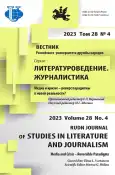Crisis of political communication: is there a silencing effect in Russian media?
- 作者: Dolgova Y.I.1, Gulenko P.V.2
-
隶属关系:
- Lomonosov Moscow State University
- Charles University
- 期: 卷 28, 编号 4 (2023): Media and Crisis – Reversible Paradigms
- 页面: 769-779
- 栏目: JOURNALISM
- URL: https://journal-vniispk.ru/2312-9220/article/view/319112
- DOI: https://doi.org/10.22363/2312-9220-2023-28-4-769-779
- EDN: https://elibrary.ru/FGNRCC
- ID: 319112
如何引用文章
全文:
详细
The authors investigate the agenda of the so-called ‘big three’ TV channels and popular online media during the presidential elections 2018 in Russia. In the context of an election campaign, the significance of qualitative public awareness grows exponentially. The given research studies the agenda of those media, the coverage of the election campaign, and also the possible ‘silencing effect’. An unique research design that allowed the content comparison between evening TV news and online media is developed, and also the notion of ‘silencing effect’ is conceptualized. Online media are often considered more qualitative and full-fledged sources of information; nevertheless, the research demonstrates that information concerned the elections was published on the Internet on a smaller scale and irregularly. The study confirmed that television in Russia, first of all, was an assistant to the government, directing its efforts to inform citizens about authorities and their socially significant initiatives. Besides, television covered the presidential elections in a better extent. Online media devoted more attention to scandalous news, attempted to criticize the government; however, they overlooked significant social issues.
作者简介
Yulia Dolgova
Lomonosov Moscow State University
编辑信件的主要联系方式.
Email: YIDolgova@gmail.com
ORCID iD: 0000-0001-8861-0521
кандидат филологических наук, доцент, доцент кафедры телевидения и радиовещания, факультет журналистики
9 Mokhovaya St, bldg 1, Moscow, 125009, Russian FederationPetr Gulenko
Charles University
Email: pgulenko@gmail.com
ORCID iD: 0000-0002-6084-821X
кандидат филологических наук, докторант кафедры социологии, факультет гуманитарных исследований
5 Patkova St, Prague, 18200, Czech Republic参考
- Abdulla, S.M. (2022). The concepts of deictic shift theory and discourse theory of silencing. Education Quarterly Reviews, 5(1). https://doi.org/10.31014/aior.1993.05.01.441
- Cushion, S., Kilby, A., Thomas, R., Morani, M., & Sambrook, R. (2018). Newspapers, impartiality and television news: Intermedia agenda-setting during the 2015 UK general election campaign. Journalism Studies, 19(2), 162-181. https://doi.org/10.1080/1461670X.2016.1171163
- Dolgova, Yu.I., & Pimenova, M.V. (2020). Interactive elements in the program “Direct Line with Vladimir Putin” (2001-2018). Vestnik Moskovskogo universiteta. Seriya 10. Zhurnalistika, (1), 59-78. (In Russ.) https://doi.org/10.30547/vestnik.journ.1.2020.5978
- Entman, R.M. (1990). Democracy without citizens: Media and the decay of American politics. Oxford University Press.
- Gulenko, P.V., & Dolgova, Yu.I. (2021). Evolution of interactive elements in socio-political talk shows in post-Soviet Russia. Global Media and Communication, 17(1), 25-43. https://doi.org/10.1177/1742766520946471
- Gulenko, P.V. (2021). Political discussion as a propaganda spectacle: Propaganda talk shows on contemporary Russian television. Media, Culture & Society, 43(5), 906-924. https://doi.org/10.1177/01634437209742
- Kellam, M., & Stein, E.A. (2016). Silencing critics: Why and how presidents restrict media freedom in democracies. Comparative Political Studies, 49(1), 36-77. https://doi.org/10.1177/0010414015592644.
- Lumsden, K., & Morgan, H. (2017). Media framing of trolling and online abuse: Silencing strategies, symbolic violence, and victim blaming. Feminist Media Studies, 17(6), 926-940. https://doi.org/10.1080/14680777.2017.1316755
- Maier, S.R., & Tucker, S. (2012). Online news readers get different news mix than print. Newspaper Research Journal, 33(4), 48-62. https://doi.org/10.1177/073953291203300405
- Maier, S.R. (2010). All the news fit to post? Comparing news content on the web to newspapers, television, and radio. Journalism & Mass Communication Quarterly, 87(3-4), 548-562. https://doi.org/10.1177/107769901008700307
- Mancini, P. (2013). Media fragmentation, party system, and democracy. International Journal of Press/Politics, 18(1), 43-60. https://doi.org/10.1177/1940161212458200
- McQuail, D. (2010). Mass communication theory. London: Sage.
- Proskurnova, E.L., Tran Thi Thuy Dung, & Volkova, I.I. Prospects of news televsion: Materials of in-depth interviews. Nauchnyi Dialog, (3), 157-170. (In Russ.) https://doi.org/10.24224/2227-1295-2021-3-157-170
- Stromback, J., & Kaid, L.L. (2008). A framework for comparing election news coverage around the world. In J. Stromback & L.L. Kaid (Eds.), The Handbook of Election News Coverage Around the World (pp. 1-21). New York: Routledge.
- Thiesmeyer, L. (Ed.) (2003). Discourse and silencing: Representation and the language of displacement. Amsterdam: John Benjamins Publishing.
- Valenzuela, S., Puente, S., & Flores, P.M. (2017). Comparing disaster news on Twitter and television: An intermedia agenda setting perspective. Journal of Broadcasting and Electronic Media, 61(4), 615-637. https://doi.org/10.1080/08838151.2017.1344673
- Voltmer, K. (2004). Mass media and political communication in new democracies. New York: Routledge.
- Williams, B.A., & Delli Carpini, M.X. (2004). Monica and Bill all the time and everywhere: The collapse of gatekeeping and agenda setting in the new media environment. American Behavioral Scientist, 47(9), 1208-1230. https://doi.org/10.1177/0002764203262344
补充文件









